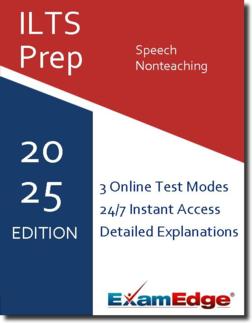ILTS Speech Nonteaching (154) Practice Tests & Test Prep by Exam Edge - Topics
Based on 20 Reviews
- Real Exam Simulation: Timed questions and matching content build comfort for your ILTS Speech Nonteaching test day.
- Instant, 24/7 Access: Web-based ILTS Speech-Language Pathologist Pathologist Nonteaching practice exams with no software needed.
- Clear Explanations: Step-by-step answers and explanations for your ILTS exam to strengthen understanding.
- Boosted Confidence: Reduces anxiety and improves test-taking skills to ace your ILTS Speech-Language Pathologist Pathologist Nonteaching (232).

Understanding the exact breakdown of the ILTS Speech-Language Pathologist Pathologist Nonteaching test will help you know what to expect and how to most effectively prepare. The ILTS Speech-Language Pathologist Pathologist Nonteaching has 100 multiple-choice questions The exam will be broken down into the sections below:
| ILTS Speech-Language Pathologist Pathologist Nonteaching Exam Blueprint | ||
|---|---|---|
| Domain Name | % | Number of Questions |
| Foundations of Communication | 19% | 19 |
| Students with Communication Disorders | 31% | 31 |
| Assessment of Communication Disorders | 19% | 19 |
| Program Planning and Intervention for Students with Communication Disorders | 19% | 19 |
| Collaboration and Professional Responsibilities | 12% | 12 |


